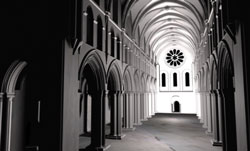 |
 |
 |
 |
 |
 |
 |
|
Lighting
Whereas lighting was excessive at the Benedictine house of Cluny – and reached a climax at Christmas and Easter when a huge corona bearing almost 500 candles was lit in the church(16) - the Cistercians regulated against the superfluous use of candles and lanterns, which they considered an unnecessary expense. There was, after all, little need for additional lighting, for, with the exception of the night office of Vigils, all liturgical duties and work were completed during the hours of daylight. Twelfth-century legislation permitted a maximum of five lamps throughout the church: one illuminated the sanctuary step, the others lit the centre of the monks’ choir, the retrochoir, the lay-brothers’ choir, and the rear area where guests might be seated.(17) Liturgical lighting in the sanctuary was also restricted. Two wooden or iron candlesticks flanked the altar, and a single oil lamp burned before the High Altar on solemnities; from 1195 this was increased to three, but candles were not actually placed on the altar until the sixteenth century.(18) In stark contrast, the High Altar at Cluny was illuminated and adorned with a vast number of golden candelabra and candlesticks, and at Christmas two golden candlesticks were placed upon the altar.(19) Although the Cistercians restricted artificial lighting, they fully exploited natural light. Windows, which kept out the wind and rain, provided illumination and could provide considerable brightness during the day; problems might arise, however, in the early morning when there was little daylight. This may have been the cause of a mishap at Communion, when Abbot Guy of Trois-Fontaines, Champagne, discovered, to his horror, that there was no wine in the chalice. It has been suggested that the server had put water into the chalice, instead of wine, an easy mistake to make if white wine was used in the early dawn, by the half-light of candles.(20) |
